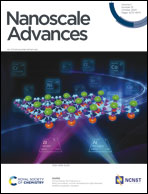The long-range π-conjugation between electron-rich species and multiwall carbon nanotubes influences the fluorescence lifetime and electromagnetic shielding†
Abstract
The efficient dispersion of carbon nanotubes in a given polymer matrix remains an open challenge. Unless addressed, the full potential of carbon nanotubes towards influencing electronic properties of a composite is far from being well understood. Although several reports are available in an open forum that addresses this challenge using various strategies, a mechanistic insight is still lacking. Herein, we have conjugated different electron-rich species with multi-walled carbon nanotubes. We systematically studied their properties by fluorescence lifetime measurements using time-correlated single-photon counting and by density functional theory. Although such conjugations vary with the electronic structure of the electron-rich species, theoretical and computational modeling sheds more light on the actual orientation of such conjugation. Taken together, the fluorescence lifetime and the type of conjugation allowed us to gain mechanistic insight into this conjugation, which further influenced several key properties of the composites. Herein, we attempted to understand these factors influencing the electrical conductivity, and electromagnetic (EM) shielding efficiency in the composite. With the addition of aminoanthracene, which established a T-shaped conjugation with multiwall carbon nanotubes (2 wt%), a remarkable −25 dB shielding effectiveness was achieved with 87% absorption for a shielding material of just 1 mm thick. The actual shielding mechanism, effect of the electronic structure, and the co-relation with the fluorescence lifetime opens new avenues in designing composite-based EM shielding materials.



 Please wait while we load your content...
Please wait while we load your content...